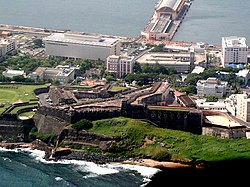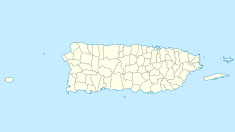Castillo San Cristóbal (San Juan)
This article has multiple issues. Please help improve it or discuss these issues on the talk page. (Learn how and when to remove these messages)
|
| Castillo San Cristóbal | |
|---|---|
 Aerial view of Castillo San Cristobal | |
| Location | San Juan, Puerto Rico |
| Coordinates | 18°28′02″N 66°06′40″W / 18.4672°N 66.1111°W |
| Built | 1783 |
| Governing body | National Park Service |
| Official name | Castillo San Cristóbal |
| Type | Cultural |
| Criteria | vi |
| Designated | 1983 (7th session) |
| Part of | La Fortaleza and San Juan National Historic Site in Puerto Rico |
| Reference no. | 266[1] |
| State Party | United States |
| Region | North America and West Indies |
| Official name | Castillo San Cristóbal |
| Designated | October 15, 1966 |
| Part of | San Juan National Historic Site |
| Reference no. | 66000930[2] |
Castillo San Cristóbal,[3] is a fortress in San Juan, Puerto Rico. It was built by the Spanish to protect against land based attacks on the city of San Juan. It is part of San Juan National Historic Site.
Castillo San Cristóbal is the largest fortification built by the Spanish in the New World. When it was finished in 1783, it covered about 27 acres of land and partly encircled the city of San Juan. Entry to the city was sealed by San Cristóbal's double gates. After close to a hundred years of relative peace in the area, part of the fortification (about a third) was demolished in 1897 to help ease the flow of traffic in and out of the walled city.
This fortress was built on a hill originally known as the Cerro de la Horca or the Cerro del Quemadero, changed to Cerro de San Cristóbal in celebration of the Spanish victories ejecting English and Dutch interlopers from the island of this name in the Lesser Antilles. At the time, it hen formed part of the insular territorial glacis of Puerto Rico.
Castillo de San Cristóbal also contains five cisterns that were used for the storage of water during the ages of the Spanish Colony. They are extremely large (24 ft tall, 17 ft wide and 57 ft long) and were used as bomb shelters during World War II.
Historical timeline

1521 – San Juan founded by Spanish settlers from Caparra.
1539 – Construction of the first fortified defenses at Castillo San Felipe del Morro and La Fortaleza, with batteries aimed at the harbor entrance.
1595 – The English attack San Juan, led by Sir Francis Drake, 25 ships penetrated the line of fire from El Morro. At the end of the battle the English fled taking some prisoners but no treasure, the reason for which they attacked.

1598 – The English attack San Juan a second time, this time led by George Clifford who wanted to clean England's honor which had been "dirtied" by Sir Francis Drake's defeat, he organized the greatest squadron ever put together by the English against Spain. The first battle resulted in a Spanish victory, but the exhausted Spanish troops couldn't impede the English entry into San Juan. On 18 June Cumberland with his forces advanced and then swept into San Juan's streets meeting little resistance; he found that some of the citizenry had already fled.[5] The government officials and other residents had taken refuge in El Morro and 250 Spanish soldiers are ensconced within the Morro Citadel. Soon after the town had been occupied, the English had artillery ferried ashore from their fleet and a formal siege was instituted.[5] Two days later the siege was under way and El Morro was bombarded from both land and sea while in the meantime Cumberland set about sacking the town. Knowing that the Spanish were short of supplies, the English preferred to lay siege to the castle of El Morro rather than destroy it.[8] After nearly 16 days huddled inside El Morro, short of food and ammunition and being constantly bombarded, the Spanish governor Antonio Mosquera requested terms on 30 June for a surrender. Cumberland refused this request and set his own terms for the Spanish surrender of which Mosquera eventually agreed to.[9] He and his followers were repatriated to Cartagena several weeks later.[5]
The victory had cost Cumberland nearly 60 casualties; however, as the same dysentery that had crippled much of the Spanish it had then spread to Cumberland's men, incapacitating nearly 600 - 700 of them as well as which included forty accidents.[10][11] With barely enough troops to crew his ships, much less maintain control of the prize he had seized from Spain, Cumberland finally decided to leave the island. Before he left however he ordered the sacking of San Juan and then ordered the destruction of the crops. His troops stole the organ and bells from the cathedral and took booty ranging from 2,000 slaves to a marble windowsill that caught his eye.[11] Cumberland sailed for England with some ships on 14 August, then on 23 September Berkeley followed with his main body along with around 70 artillery pieces from the fort.[12] Clifford on his return to England was proclaimed as a hero of sorts and as a consequence with his limited booty was well rewarded for his efforts including a patent from the Queen.

1625 – The Dutch attack and take San Juan from the land side. Construction of some form of defense for San Cristóbal Hill ordered to prevent other attacks from the land side.
1634 – A small triangular redoubt is built on the high ground known as San Cristóbal on the northeast side of San Juan.[4]
1766–1783 - Main period of construction of San Cristóbal as we see it today under the directions of Royal Engineers Tomás O’Daly and Juan Francisco Mestre.[4]: 61–65
1787 – An earthquake damages the structure of both San Felipe del Morro and San Cristóbal.[5][6]
1797 – San Cristóbal helps repel the attack on San Juan from the land side by a British invasion force of 7,000 - 13,000 men commanded by Sir Ralph Abercromby. Abercromby's forces, one of the largest ever to invade Spanish territories in America, are halted a mile from San Cristóbal at the Escambrón defenses, also known as San Juan's First Line of Defense; see Fortín de San Gerónimo.
1824 – María de las Mercedes Barbudo, a political activist who was the first female from Puerto Rico "Independentista", meaning that she was the first Puerto Rican woman to become an avid advocate of Puerto Rican Independence,[7] and who joined forces with the Venezuelan government, under the leadership of Simon Bolivar, to lead an insurrection against the Spanish colonial forces in Puerto Rico.,[8] was held captive in the fort pending her exile to Cuba.
1855 – Mutiny by the San Cristóbal artillery brigade against the Spanish crown. The Castillo is held by rebels for 24 hours causing panic in the city when the cannons are turned around and aimed at the city.
1897 – A large segment of 18th century walls are dynamited from San Cristóbal to the harbor docks to allow San Juan to expand.

1898 – On 10 May 1898, the first shot which marked Puerto Rico's entry into the Spanish–American War was ordered by Captain Ángel Rivero Méndez is against the USS Yale from Castillo San Cristóbal's cannon batteries. San Cristóbal's gunners duel with US Navy warships during a day-long bombardment 10 May 1898. Six months later Puerto Rico becomes US territory by terms of the Treaty of Paris which ends the Spanish–American War.

1942 – Still an active military base when the United States entered World War II, concrete pillboxes and an underground bunker control center are added to the ancient defenses of the Castillo San Cristóbal. Cisterns were to be used as fallout shelters.
1949 – San Juan National Historic Site is established as the most impressive structure in the new world.
1961 – The US Army moves out of the forts of Old San Juan, and they become the jurisdiction of the United States National Park Service, to be preserved solely as museums.
1983 – San Juan National Historic Site is declared a World Heritage Site by the United Nations.
La Garita del Diablo

Most of San Juan's fortified walls have guerites (sentry boxes, "garitas" to the locals) at various points. One of the guerites at Castillo San Cristóbal is called "The Devil's Guerite" ("La Garita del Diablo"). This guerites offer a vantage point to watchmen guarding the sea shore, while protecting them. This particular guerite is one of the oldest parts of the fort being built in 1634.[9]
There are several legends surrounding the guerite. Some of them say that soldiers disappeared randomly from the guerite. However, it is mostly believed – and told so in various local stories – that the only soldier that apparently disappeared was a soldier called Sánchez, who fled his post to escape with his girlfriend, called Dina.[10][11][12] However, the legend still surrounds the guerite. Although, it is currently inaccessible to the general public, it can be seen from the upper part of the fort.
See also
Notes
- ^ "La Fortaleza and San Juan National Historic Site". UNESCO. Retrieved November 25, 2012.
- ^ "National Register Information System". National Register of Historic Places. National Park Service. July 9, 2010.
- ^ www.nps.gov National Park Service - San Juan National Historic Site - The Gibraltar of the Caribbean - Consulted el 2014-11-29
- ^ a b The Forts of Old San Juan. Washington, D.C.: Division of Publications, National Park Service, U.S. Dept. of the Interior. 2018. pp. 52–53, 62–63. ISBN 9780912627625.
- ^ El Morro, San Cristobal y San Geronimo en peligro en caso de terremoto Archived January 8, 2014, at the Wayback Machine on NoticiasOnline (6/7/2009)
- ^ Flores, Milagros (1999). "San Juan National Historic Site Celebrates Its 50th Anniversary" (PDF). Culture Resource Management. 22 (5). US Department of the Interior, National Park Service: 5–7. Retrieved 8 November 2020.
- ^ "Meaning of "Independentista"". Dictionary.reverso.net. Retrieved 2018-03-05.
- ^ Mercedes - La primera Independentista Puertorriquena Archived 2011-04-21 at the Wayback Machine
- ^ "Old San Juan Historic District" (PDF). NPS. WBM: United States Department of the Interior. Archived from the original (pdf) on April 11, 2019. Retrieved 31 July 2019.
- ^ Dr. Cayetano Coll y Toste. "La Garita del Diablo".
- ^ "Leyenda de la Garita del Diablo". Archived from the original on 2007-01-14.
- ^ Antonio Bou. "La garita del diablo".
External links
- Castillo San Cristóbal on Facebook
- National Park Service - San Cristóbal
- 1898 Sociedad Amigos de la Historia de Puerto Rico
- Las Líneas de Defensa de San Juan, Compilación por Johnny Torres Rivera
- Historic American Building Survey - Fortifications of San Juan, Outer Defenses, Puerta de Tierra, San Juan, San Juan, PR[permanent dead link]
- Las defensas de San Juan 1898, Compilación por Luis M. Iriarte Rota
- The Forts of Old San Juan:Guardians of the Caribbean, a National Park Service Teaching with Historic Places (TwHP) lesson plan


